AMABHUNGANE
Cradle of Conflict: A tangled web of colliding interests over Portion 7 Rhenosterspruit JQ
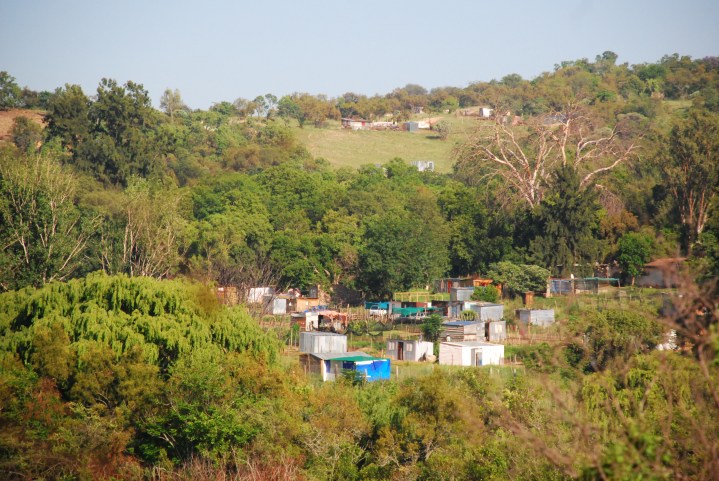
In the Cradle of Humankind, a landless community divided over property rights is running out of options as it fights for space and belonging in a ‘landowner’s paradise’.
The trucks came at sunrise. Crunching gravel and billowing dust announced the arrival of disaster.
With each blow of each sledgehammer, every home and the lives it contained were reduced to the sad sum of their parts. Zinc sheets, plywood and the rusty nails that held it all together. Couches, beds and kettles exposed through fences that once protected private space. The heat. Under the naked November sun listless children and their pets wandered among the things or sat on bare ground under trees.
They had slept, bathed and belonged there less than five hours earlier. Now it was no longer home. Had it ever been?
The eviction site, Portion 7 Rhenosterspruit JQ, was once destined for much greater things. Wraypex, the developers of the nearby Blair Atholl luxury golf estate, promised to build 250 houses, a community centre, a school, and a golf academy.
Beyond amenities, Portion 7 also once offered the hope for justice and reform for farm dwellers trying to turn the corner on a history of land hunger and abuses by powerful landowners in the Cradle of Humankind.
Briefly it was a beacon for the power of community and collaboration in the face of difficulties cemented by centuries of discrimination.
That was 14 years ago.
Today Portion 7 is a battle site for a community divided against itself.
Wraypex has long abandoned its promises to the people of Rhenosterspruit, in a situation that steadily worsened under the minimal guidance and enforcement provided by environmental affairs and rural development authorities.
The community leaders who united to represent the dispossessed have been torn apart by infighting.
Once united against a common threat, they are now struggling to define a united vision of community and belonging.
You see, the man who called in the trucks, who initiated the evictions, is one of their “own”: William Moagi.
Prelude
For generations, black presence in the “landowner’s paradise” of Rhenosterpruit was only welcome in exchange for labour on its many commercial farms. Those workers who died, or fell foul of white landowners, or retired, lost tenure for their entire families.
Moagi’s homeland is Rhenosterspruit, in the heart of the Cradle of Humankind, where homo naledi, the skull of mankind’s oldest common ancestor, was unearthed in 2015.
Just like homo naledi, the cradle has held the bones of Moagi’s ancestors for ages.
So in November 2017, Moagi, now a landowner, did what he felt he must to protect what had been owed and denied to his family for generations.
He ordered the demolishment and eviction of 600 shacks on the farm Portion 7 Rhenosterspruit JQ.
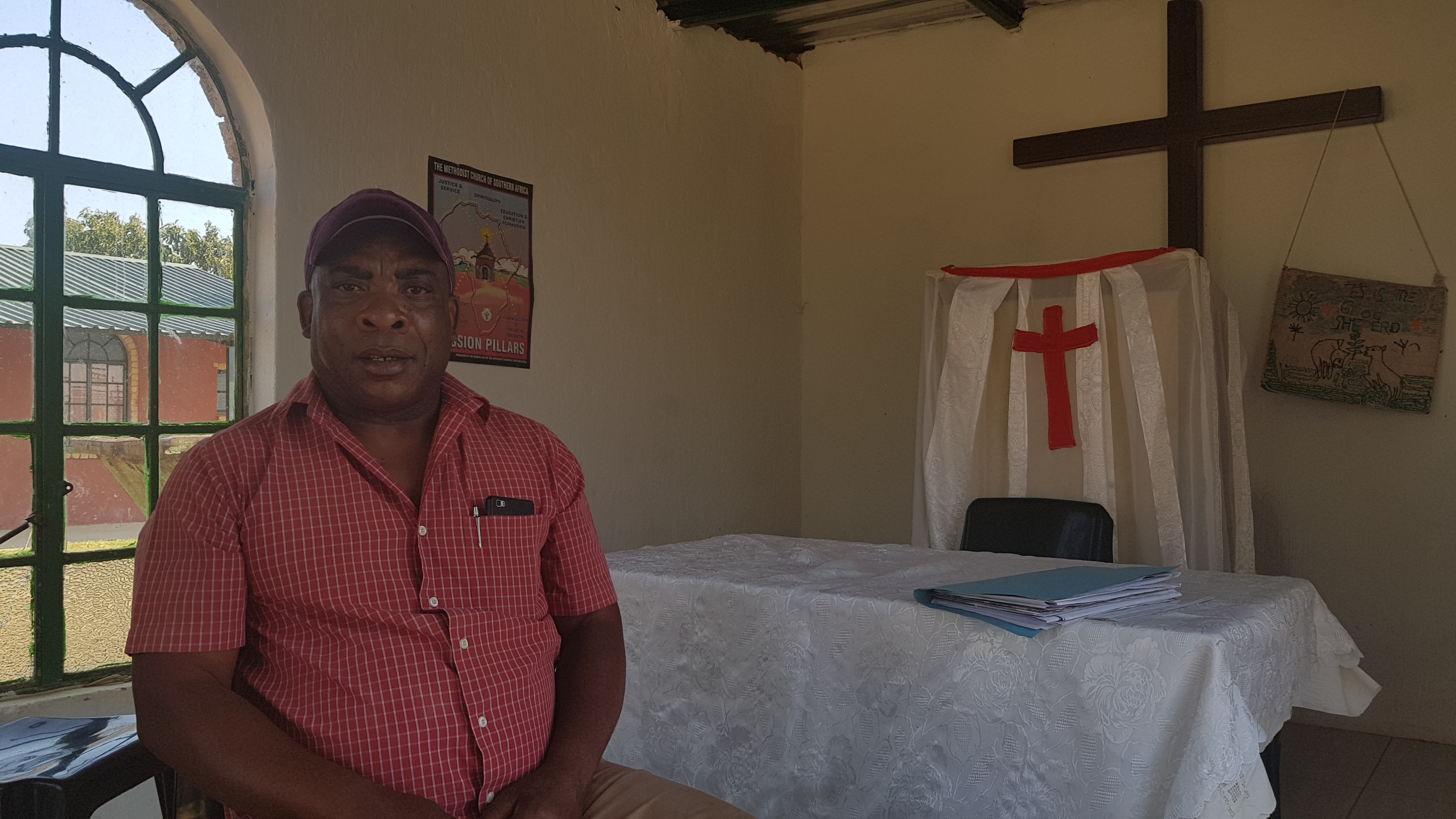
William Moagi, Chairman of the Cradle Communal Community Property Association
Moagi is the chairman of the Cradle Communal Property Association (CCPA), which holds the title deed to Portion 7.
The CCPA have been locked in a dispute for years with former allies David Mkhonza and Farayi Moyo, who have formed a breakaway organisation, the Cradle Community Trust (CCT).
At the heart of the dispute is the right to own and occupy Portion 7.
That right is based on the terms of a negotiated settlement with Wraypex that provided for the local landless people to benefit from the construction of South Africa’s most expensive estate, Blair Atholl, which started development in 2004.
The terms of the settlement were captured in an official document called an environmental authorisation (EA) and issued by the Gauteng Department of Agriculture and Rural Development (GDARD).
The document was ambiguously worded and poorly enforced, leading to a dispute which split the CCPA leadership into factions which both claim to represent the true beneficiaries of Portion 7.
To make matters worse, after over a decade, the true futility of their conflict is coming to light.
GDARD has belatedly confirmed that Portion 7 is a white elephant.
Its foundations are made of the same dolomitic earth that has been ideal for preserving the fossils of the cradle, but dangerous for human habitation. The land threatens to open and swallow all.
Still, those who believe they belong on Portion 7 fight on.
But to understand that, we need to go back to the early 2000s and the way in which an act of generosity was mishandled and betrayed.
The Vision
“People can talk about this land like it’s a donation, but to us it is so much more,” says Moagi.
“It’s always been ours. Our mothers and fathers worked and watered this land with their blood, sweat and tears.”
As chairman of the CCPA, the “us” Moagi represents are 114 families who once worked for the Zingel family.
From the 1970s until 2000, the Zingel family owned, lived and ran their businesses from the farms surrounding Portion 7, which they also owned.
They are a family of fourth-generation agricultural geneticists, whose Mayford Seed Factory was founded in the 1970s.
The Zingels owned a commercial farm, seed factory and laboratory next door and smaller plots nearby where some of their large staff complement lived.
Moagi says he grew up with Rodney Zingel, who became head geneticist in the lab.
“My grandmother carried Rodney on her back. My grandfather spent his entire life [looking after] 1,000 head of sheep. Rodney built him a home at the top of the farm where he stayed with them.”
About 70 employees bred seeds in the laboratory, grew and sold vegetables, reared livestock and cared for the property.
“Those of us who had a bit of education were trained to work in the lab with the seeds,” says Moagi. “I learnt to drive as a teenager and worked security on the farm.”
In 2000 when Rodney was approaching retirement from the Mayford factory, already under new ownership as Sakata Mayford, he approached his staff with a proposal.
At that time the Zingel workers’ houses were scattered between the family’s property in the area. Some lived on Portion 7 while Moagi and about seven other households lived on another smallholding a few hundred metres away called 134 Lindley.
Zingel wished to donate Portion 134 Lindley, the 10ha plot where Moagi was already living, to 114 families he felt he owed his own family’s success to.
Zingel and his employees began meeting regularly to plan out their vision for the development of a close-knit community that would work together to grow food and sustain themselves, as they had on the Zingel property over decades.
Meeting minutes from February and March 2003 show the group known as the “Sakata Beneficiaries” also met twice with officials from the Mogale City municipality and the national department of Land Affairs to identify the terms under which each department would be involved.
According to Zingel, the Department of Rural Development and Land Affairs instructed the Sakata families to draw up a verifiable list of beneficiaries with identity numbers.
“The list comprised employees, ex-employees, friends and small group of friends to the community,” Zingel told amaBhungane.
“It was about 113 people and their families, and the Department of Land Affairs was going to review the list of beneficiaries because non-citizens and minors would be disqualified.”
Zingel says Land Affairs also instructed the Sakata group to nominate a chairman and committee to act on their behalf.
William Moagi was voted as chairman and four other people formed his executive. When that organisation came to be called the Cradle Communal Property Association is under dispute, but CIPRO records show a section 21 company called First Reddy Development 662 was officially renamed the Cradle Community Property Association in July 2005.
Moagi says that they registered the CCPA as a non-profit company, with the executive listed as directors, for fundraising purposes only. Otherwise it functioned as a traditional Communal Property Association (CPA), responsible for co-ordinating the project with the relevant government departments as well as representing the beneficiaries in any other official engagements.
In terms of the Communal Property Associations Act of 1996, CPAs are “juristic [entities]” designed to allow disadvantaged communities to acquire, hold and manage property on “a basis agreed to by members of a community in terms of a written constitution”.
The act also requires all CPAs to be registered and monitored by the national department of Land Affairs. The CCPA, a nonprofit company, was not.
A signed, undated offer and acceptance of donation between “Rodney Trent William Zingel and the Sakata Community” specifies that ownership of the land would be held in common property, but individual houses will be held by beneficiaries in the form of title deeds.
It also specifies that property transfer costs would be borne by the Department of Land Affairs and onsite housing development and the provision of bulk services and infrastructure would be the responsibility of Land Affairs and the local municipality.
Says Zingel: “The department of land affairs made it clear that together with the selected committee members, they would oversee the proceedings as the project was theirs. The proposal was in line with the government housing scheme and they were going to finance and build the houses with services.”
In 2004, Rodney says the HW Zingel Trust then put another one of their properties up for sale: Portion 7 Rhenosterspruit JQ.
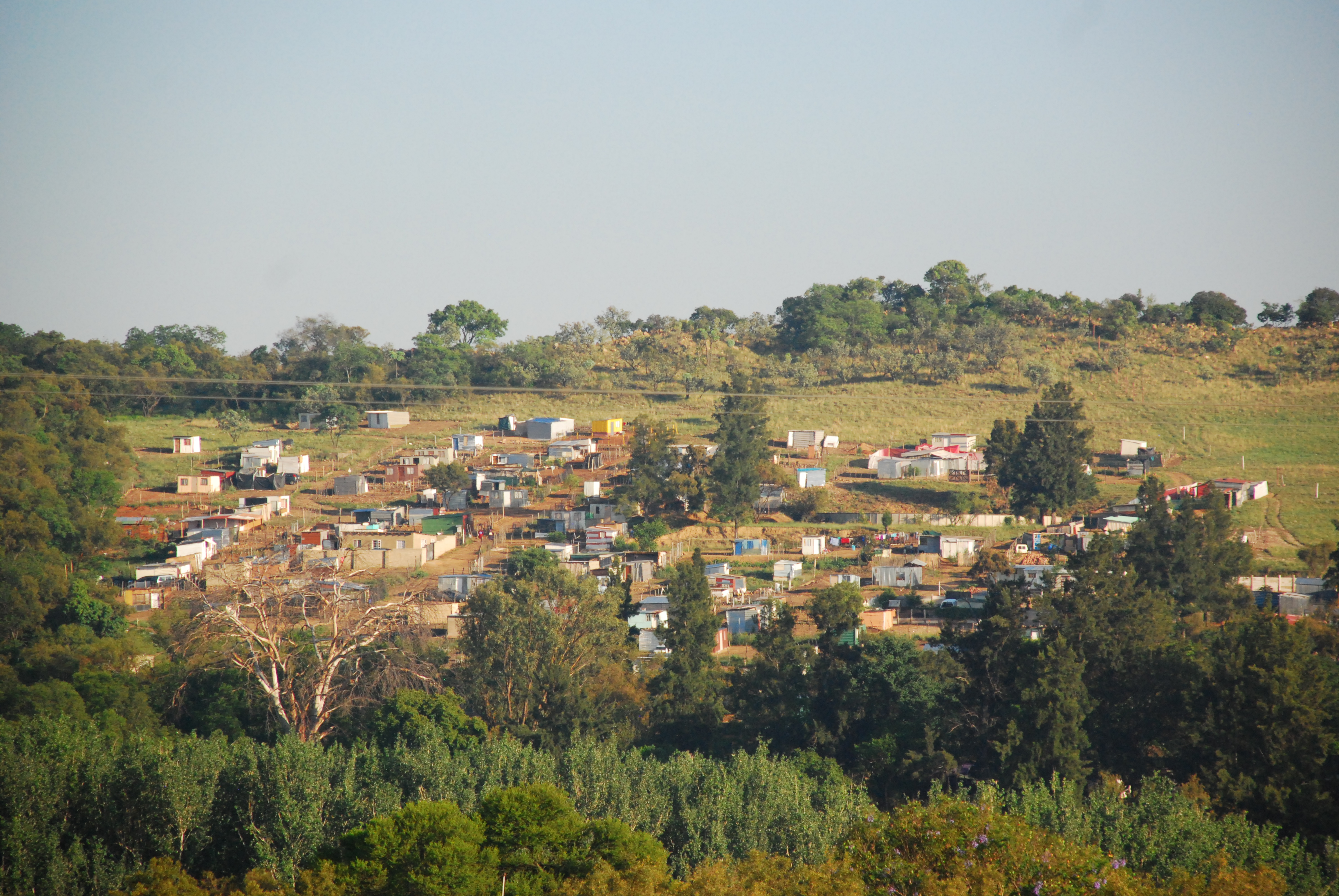
Image of Plot 7 taken from a neighbouring property in 2016
A new neighbour muddies the waters
The establishment of the co-called Sakata community township (the Zingel project planned for 134 Lindley) was not the only new development taking place in Rhenosterspruit around 2004.
Nearby, property developer Wraypex began buying 13 farms including some owned by golfing legend Gary Player. The plan was to develop an ultra-luxurious gated estate called Blair Atholl, complete with golf course designed by Player himself, a nature reserve, spa, equestrian centre and sports facilities for the exclusive use of residents.
Today homes in Blair Atholl are listed for a median price of R14-million.
Most of the 13 farms Wraypex purchased were commercial fruit, vegetable and poultry producers where the farm labourers lived with their families.
The families were evicted. Many of them, like Moagi’s family, had been in the area for generations. One news report tells of at least 21 families left homeless after their houses were demolished on the farms. A photograph shows a group of people at a large gate, reported to be locked out from collecting their belongings on the property.
Under the Environmental Management Act, vulnerable people and ecosystems like those on the Blair Atholl farms are supposed to be protected by regulations governing companies seeking permission for development. These obligations are overseen by the National Department of Environmental Affairs and its provincial offices, in this case the Gauteng Department of Agriculture and Rural Development (GDARD).
To receive authorisation for the development of Blair Atholl, Wraypex was compelled to appoint an environmental expert to conduct an assessment and develop an environmental management plan for the company to submit to GDARD.
Under the banner of the CCPA Moagi plus two other community leaders – Farayi Moyo and David Mkhonza – negotiated with the chief executive of Wraypex, Robby Wray, over the socioeconomic aspects of the environmental management plan.
Moyo was another Zingel employee and land beneficiary, who had been running a self-described “informal land rights group” in the Cradle and nearby Lanseria. He educated farm labourers and dwellers about their tenure rights and challenged farmers who abused them.
Mkhonza is from Hartbeeshoek, over the Magaliesburg mountains, where he had been involved with another CPA.
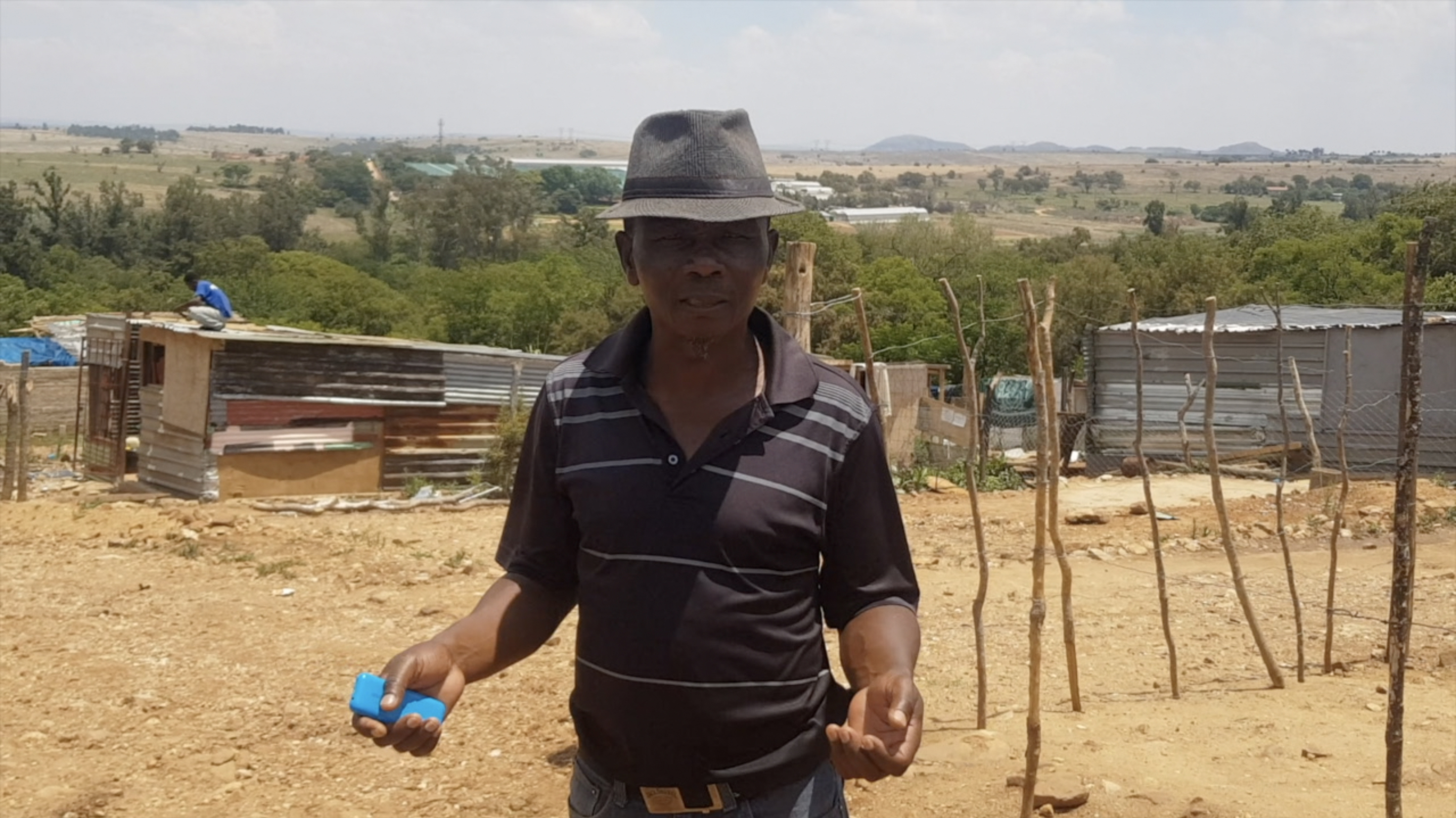
David Mkhonza
The positive environmental authorisation Gauteng issued to Wraypex on the 14th of June 2005 contained specific terms for offsetting the existing socioeconomic conditions in the cradle that would be exacerbated by the development.
One requirement was for Wraypex to provide “security of tenure” for hundreds of families surrounding the development. There were several legs to this commitment. The agreement said:
“Wraypex have committed themselves… to provide for accommodation for all families currently residing on the site to remain on the site but in improved living conditions. Formalised, serviced accommodation will be provided.”
Wraypex further committed to purchase a neighbouring farm which would be transferred to the CCPA. Wraypex would fund and manage all zoning and environmental applications required in order for the beneficiaries to obtain and utilise the land purchased for them.
In addition Wraypex promised to move a school situated on the development site to a new location, donate R1-million annually to the school’s fundraising efforts and establish a community centre on its premises.
Wraypex also pledged to build a Gary Player golf academy for “previously disadvantaged people of the area”.
The authorisation did not specify who exactly the families on the development site were, nor did it specify which families would “remain on the Blair Atholl site” and which would “obtain and utilise” the nearby farm transferred to the CCPA.
A month later GDARD issued an errata that differentiated between 30 families living on the actual site of Blair Atholl, and 250 families that would benefit from the purchase of the nearby farm.
The errata had introduced a new, unspecified and ambiguous group, “approximately 250 families residing in the geographical area near the development site.”
And it conflated the interests of the broader affected community with those of the CCPA — an organisation representing a very specific, distinct group who was already working on their own development on the Zingel’s 134 Lindley property nearby.
Problematically, it designated the CCPA as the “representative of all families living on the Blair Atholl site”.
How? It began with one “neat swap” that ended with very messy consequences.
A swap that unravelled.
Robby Wray, CEO of Wraypex, wanted 134 Lindley for access to build a road to the main gate of Blair Atholl.
That land, already donated to the Sakata Families, was not for sale, but Zingel says Wray approached him in 2004 with a purchase offer of R2-million.
The donation agreement between Rodney Zingel and the CCPA had already been signed – but the title deed was still in the name of the Zingel family trust.
“Most of the farmworkers already lived on Portion 7, it was just a few of us on Lindley,” says Moagi.
So Zingel and the CCPA reached an agreement with Wrapyex. If the plan had succeeded, it would solve multiple problems for the property developer and the beneficiaries.
Instead of 134 Lindley, Portion 7 would become the new permanent donated home for the former Zingel farm workers.
“It was meant to be a neat swap,” says Moagi.
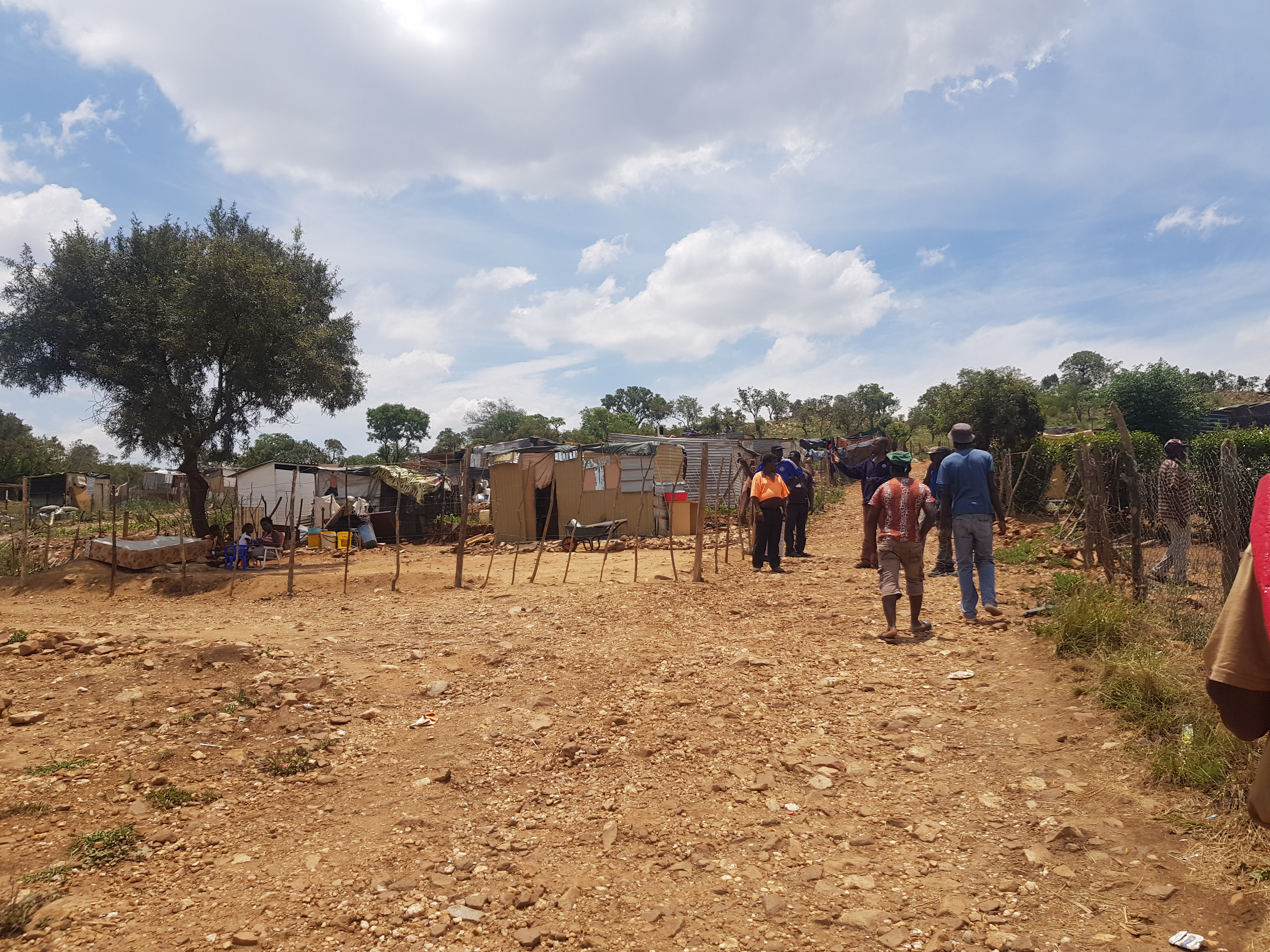
Plot 7
At 165ha, Portion 7 is much bigger than the 10ha Zingel donated to the Sakata families. Robby Wray planned to subdivide the land, give 10h to the CCPA and use the rest to satisfy the terms of the environmental management plan he submitted to GDARD.
When the development authorisation was issued a year later, it became clear that Portion 7 was the mentioned “neighbouring farm” that would offer security of tenure for the 250 affected families and where the school and community centre would be moved (It’s unclear where Wraypex planned to put the golf academy that never happened).
“The people that Wraypex put on their land would have been our neighbours,” says Moagi. “We would have lived together with a fence separating the portion that we own, of course.”
Wraypex purchased all 165ha of Portion 7 for R2-million from the Zingel Trust, bundled with the 10ha Lindley farm into the deal for an extra R1. It wasn’t exactly clear why Wraypex didn’t purchase both properties at full price, Rodney Zingel explained it as:
“Something Robby said about saving money on taxes.”
The purchase agreement between the Zingel Trust, Wraypex and the CCPA as a third-party signatory was finalised on the 1st of October 2004.
Wraypex bound itself to subdivide Portion 7 to create an area set aside for the CCPA to be known as the “cradle community portion”.
Wraypex would also transfer R1-million to them for the purpose of establishing infrastructure on that part of the land.
“Wraypex said that since they’d be putting in lighting and roads right next door they’d give us R1-million to help the Sakata people set up the same for ourselves,” Moagi recalls.
Moagi’s care to insist on a fence, literal and proverbial, between the 114 Sakata families and the landless group referred to in the environmental authorisation gets at the heart of his dispute with his former allies Moyo and Mkhonza, who now lead the breakaway Cradle Community Trust (CCT).
Moagi insists the CCPA was never meant to represent all families “residing in the geographical area of the Blair Atholl site” and functioned exclusively for the interests of the Sakata families benefiting from the Zingel donation.
Because of the close-knit nature of the farming community, he and the Sakata beneficiaries had friends and family affected by the Blair Atholl evictions and the CCPA used its formalised status to represent them.
That is how he came together with Mkhonza and Moyo, who Moagi says took advantage of their affiliation to claim membership of the CCPA and use its name to push their interests.
“Moyo and Mkhonza were up and down this area taking up causes for landless people. It was their operation. That’s how they even came to be involved with Blair Atholl. Neither of them are from the Blair Atholl farms. Mkhonza is not from this area at all.”
Moagi says he allowed Moyo and Mkhonza to negotiate as representatives of the CCPA in order to present a united front to Wray.
But a 2004 letter that bears a CCPA letterhead and was circulated to Wraypex, the local municipality and community notice boards announced Mkhonza’s election to serve on the CCPA committee. The notice is signed by the “CCPA Advisory Council” which included Farayi Moyo.
Still Moagi insists, “Mkhonza elected himself as acting secretary. It’s a title he gave himself so he could get to Robby.”
“We were never part of the affected Blair Atholl families, and we had no problem sharing land, but my loyalty was always to my Sakata community.”
The environmental authorisation also specified that Portion 7 be developed concurrently with the Blair Atholl site so that the community housed there could benefit from being “integrated” with Blair Atholl.
To that effect Wraypex was compelled by GDARD to provide the department with a detailed timeline for the development of Portion 7, as well as “an indication of the level of services and top structures to be provided for the beneficiaries and time lines linked to this” and “a plan for integration of the two developments”.
But by the time Blair Atholl opened in 2007 Portion 7 still sat empty. No housing, no community centre or golf academy, and the school was moved to another site nearby.
Moagi says Wray informed him that he was unable to subdivide Portion 7 to separate the part allocated to the Zingel beneficiaries, “because it’s in the Cradle”.
Portion 7 is classified as a low density development within the Cradle of Humankind, a UNESCO World Heritage Site where special land use permissions apply (Land Affairs and Mogale city authorities were unable to explain to amaBhungane why they did not anticipate this problem).
By 2007 Land Affairs and Mogale city had also not progressed in their plans to help the CCPA establish a serviced township on the plot. Moagi said:
“We were told that the Department of Education had assessed that Portion 7 was unsuitable for a school. So it was moved to another farm and the teachers’ families were housed there. Just inside the gate of Blair Atholl, Wraypex built housing for all of the families who had been living inside the site.”
And so Portion 7 sat largely empty for years, except for a few old Zingel employees who had lived there for a long time, and Moyo and Mkhonza who moved into two old houses on the property in 2004.

Plot 7 a few days after the eviction
Moagi insists that the plot sat empty because all families directly affected by the Blair Atholl development were rehoused inside Blair Atholl and near the school.
He alleges that the “250 families residing in the geographical area” of Blair Atholl refer to an informal settlement much nearer to Blair Atholl called Malatji, where the residents declined to be rehoused on Portion 7.
“Otherwise wouldn’t the people who needed to live there have moved there as soon as it was bought?”
Wraypex had also failed to deliver on another promise; the R1-million donation to the development of the Sakata township planned by the Zingel beneficiaries. So, Moagi says, he approached Wray to arrange another “neat swap”.
“Since he was no longer developing the other 146ha [of Portion 7] the CCPA was interested in buying it. The only money we had was the R1-million he had promised us, so we exchanged that for the whole portion… we were given a title deed for all 156ha of Portion 7.”
The CCPA owned the entire farm, but says that without proper amenities and developments, their beneficiaries would not move in.
“We [the Sakata community] were not going to live in an unserviced, zig-zag area with izinyoka (illegally connected) electricity. Then in 2014, the shacks started mushrooming.”
The “Landowner’s paradise” and the rise of the Cradle Community Trust
Farayi Moyo says he felt compelled to continue the work that his younger brother Sam started, before he died suddenly in 1998.
Sam Moyo was a well-known land activist (infamous by some accounts) who challenged farmers and land owners over the rights of workers in the Cradle and surrounding areas.
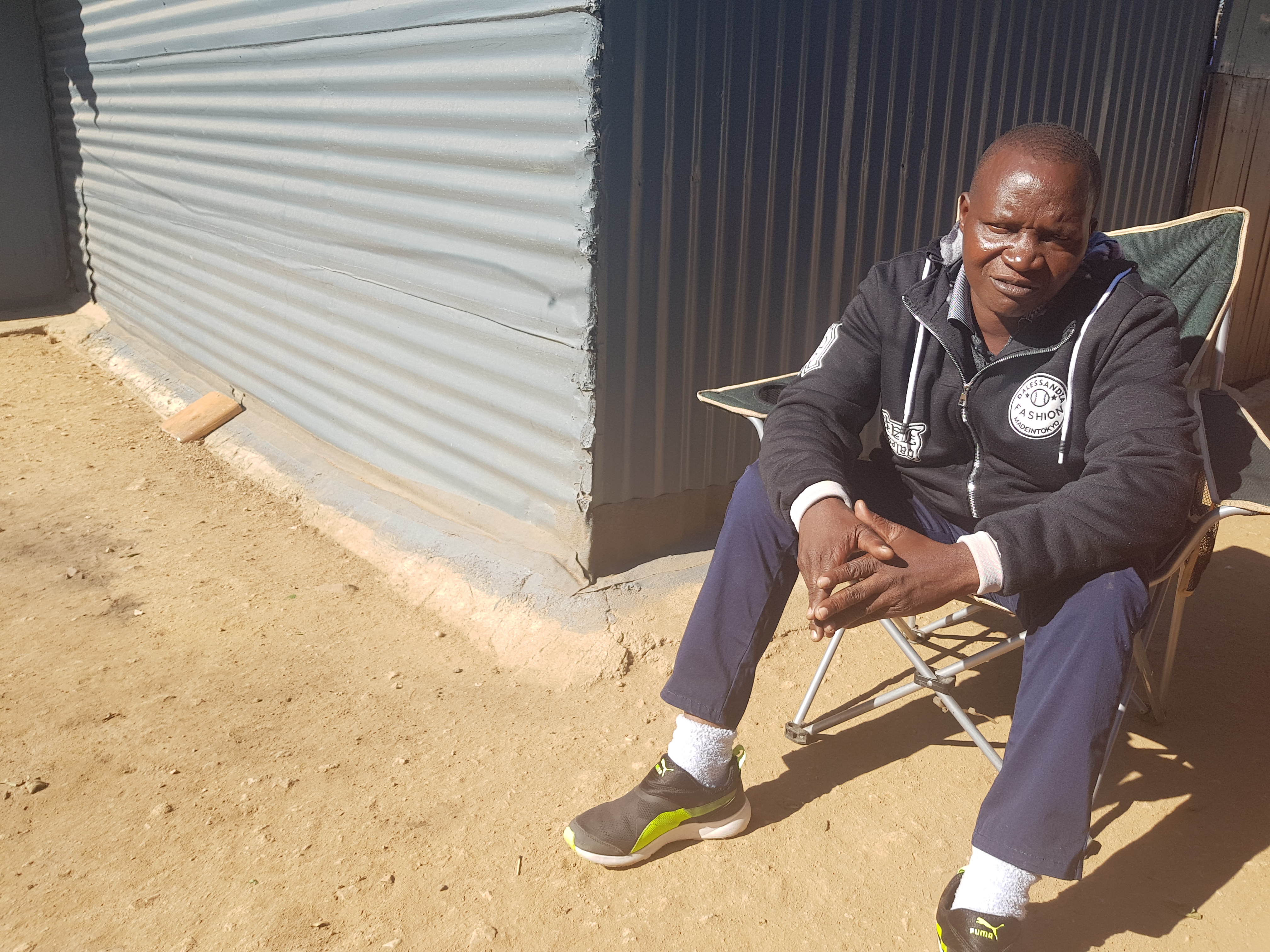
Farayi Moyo
It was Farayi who first left the small mining town of Kwekwe in Zimbabwe for a job at the Mayford Seed Factory in 1990. His younger brother Sam left a mining job and followed him in 1992.
Sam became known in the area as a friend to the poor and the young, campaigning for farm-workers’ rights in the Cradle and nearby Lanseria, described as “a landowner’s paradise” in his Mail & Guardian obituary titled “Mysterious Death”.
“It was the 1990s and the new dispensation had come up with laws like the Security of Tenure Act and the Protection of Farm Dwellers Act but people did not know their rights,” explains Farayi.
“We ran a paralegal, informal movement alongside NGOs in the area to educate and empower farm dwellers to push back at their employers.”
Moyo says his brother’s campaigning often brought him up against white farm owners in the area who were committing horrible abuses.
“Their security guards chased and assaulted people. They withheld pay. Evicted a family in the bucket of a tractor… We saw all kinds of atrocities here in the Cradle.”
According to Moyo, his brother was arrested after a clash with a local farm-owner and died shortly after his release from jail.
At his funeral, then acting Gauteng Premier Dan Mofokeng said, “This area is most difficult… The landlords here act like they are the government, the judiciary and everything. If many people believe that Sam was poisoned, we must not overrule such possibility. Here, we are not burying a foreigner, but our own son whose good work will remain with us.”
Farayi says he put his life on hold for more than 10 years to continue his brother’s work, but eventually had to stop neglecting his career and moved to Kigali, Rwanda.
When I finally meet Moyo on a visit home, it’s hard to reconcile his smiling, measured demeanour with descriptions of him as “dangerous” in interviews with two surrounding landowners.
He says he has earned the same reputation as his brother because he has challenged them to treat black people in the Cradle better.
Similarly, his experiences have left him with a serious distrust of the landowners around Portion 7. And of Moagi and the CCPA leadership.
He accuses Zingel, Wray and surrounding landowners of “chicanery” and believes they never intended to honour black landowning rights in the area.
“Moagi and them are fronters who were actually nominated by the developer [Wraypex] and one or two landowners who had sold the developer a number of farms in the area.”
Moyo says that he and Mkhonza were part of the founding leadership of the CCPA which was formed specifically to promote the interests of all landless people in the Cradle – and that Portion 7 belongs to anyone in the area who needs housing.
“We always intended to register a real communal property association with the Department of Land Affairs and enjoy their regulation and protection, but Moagi went behind our backs and registered it as a non-profit.”
In Rhenosterspruit loyalties have long been drawn along racial lines. Moyo calls Moagi the “blue eyed boy” of the surrounding white landowners.
“When they needed a signature on behalf of the so-called beneficiaries he was happy to sign. He went alone to meetings with them. That Wraypex sale agreement was signed behind the gates of [gated golf estate] Dainfern.” (Zingel lives in Dainfern.)
But there are also questions about Moyo and Mkhonza.
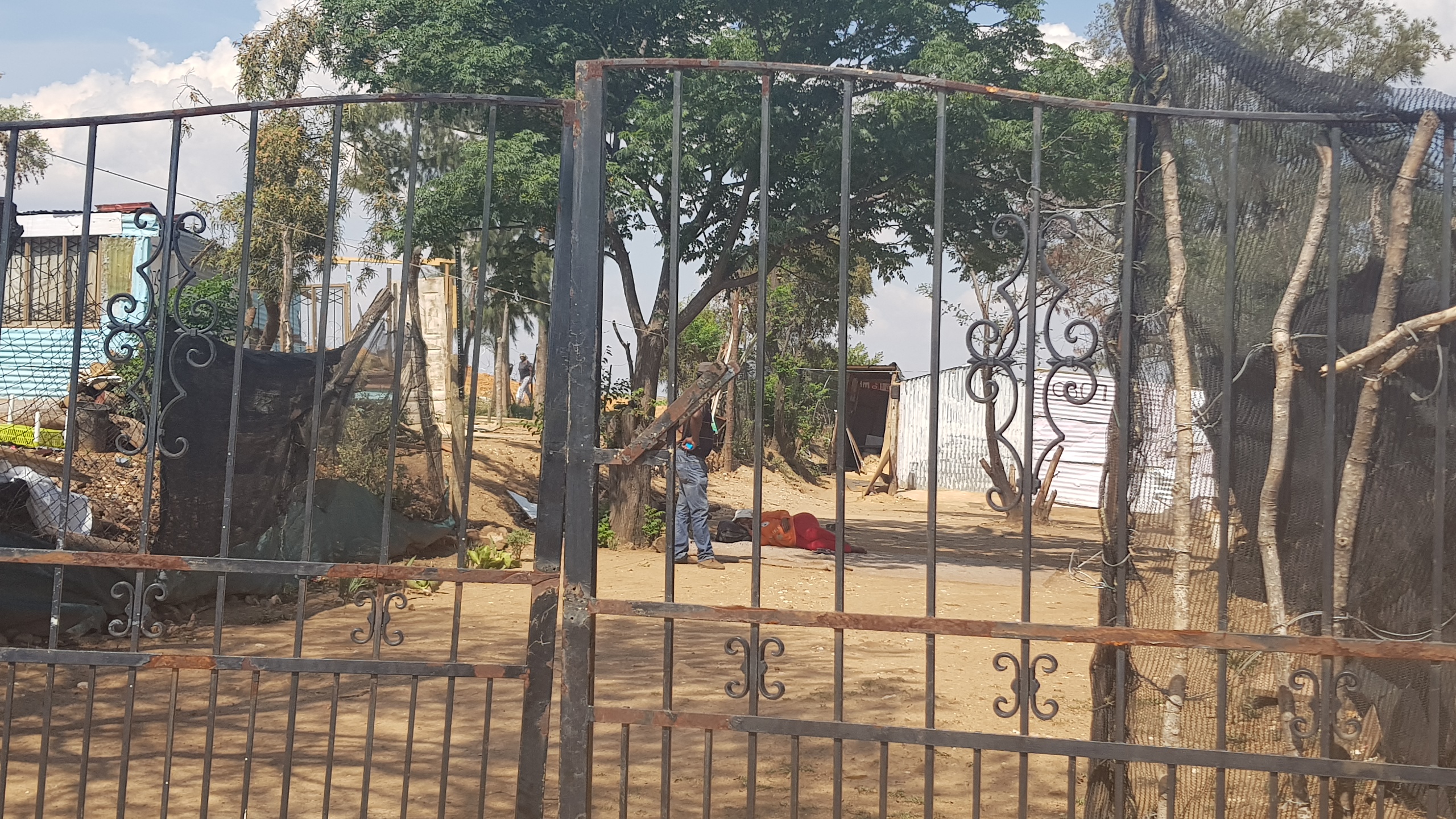
A few days after the eviction. A woman sleeps on the floor where her house once stood.
Selling stands?
After the 2017 evictions, evidence emerged of the CCT’s financial conduct. Disgruntled evictees showed Moagi receipts of payments they had made to the CCT when they moved on to Portion 7.
The receipts, for “Admin Fees”, are from 2016 for the amount of R550 and are stamped by the Cradle Community Trust. Moagi also collected sworn affidavits from former residents who alleged they paid the CCT for stands.
Moagi says the evidence demonstrates the CCT’s true motivation and who is really trying to gain financially from ownership of Portion 7.
David Mkhonza, now the self-styled induna (or headman) of Portion 7, says the admin fee is not for the sale of stands but for the administration of allocating stands and a contribution to the fees for the lawyers who represent the CCT in the ongoing fight to occupy Portion 7.
On the morning the demolition trucks came it was Mkhonza who rushed to the South Gauteng High Court an hour away, and back, to secure an interdict against the eviction. The interdict was granted five hours into the demolishment, with an order that forbade those whose structures had already been demolished from rebuilding until the dispute over the land is resolved.
In the days after the eviction, occupants who remained on Portion 7 spoke of their appreciation for Mkhonza’s efforts towards dignified life in the settlement.
This includes his co-ordinating the legal fight for Portion 7, keeping crime at bay and pressing Mogale City municipality for the provision of basic services like a weekly water truck, since the CCPA confiscated the pumps for boreholes on the site.
One older woman who had bounced around from as far as the south of Johannesburg, to Diepsloot to Rhenosterspruit told me of how Mkhonza arranged for water to be collected from the drop-off points and delivered to the doorsteps of the infirm.
Another man spoke of how he grew up less than 5km away, in the area that was now known as the the Rhenosterspruit Nature Conservancy and how his family was evicted when the conservancy was established.
They are among the people growing vegetable gardens, collecting firewood, rearing chickens and raising children on Portion 7: Trying to build lives despite being labelled as “land grabbers”.
But none of the people I spoke to were originally from “the geographical area” of the Blair Atholl development. Nor where they beneficiaries of the Sakata donation.
There’s also the issue of “foreigners” living on Portion 7, raised by almost every source interviewed by amaBhungane as proof that the CCT leadership has been misallocating space.
Mkhonza believes the problem of land insecurity that Portion 7 should address is much greater than the issues caused by Blair Atholl.
“When the Boers want the ‘foreigners’ for cheap labour, they don’t check them for IDs. When they fire them and kick them off their farms, where should they go? I’m not like that. All black people are foreigners in the Cradle so we can’t treat each other like that.”
Criminal neglect
It is clear that the disputes over Portion 7 spiralled out of control because government authorities failed to play their part from 2005 onward.
Now the problems seem intractable.
Current Mogale City mayor Patrick Lupidi visited Portion 7 in October this year, to address all parties to the dispute. His visit was the latest of many from various government officials and task teams that have paraded through the Portion 7 over the last five years.
“There hasn’t been a mayor that’s taken office in Mogale city that I haven’t met with,” says Moagi.
In a 2015 letter to then mayor Calvin Seerane, Moagi wrote:
“We also wish to enter into partnership with your office in the form of offloading some of the land to the municipality for the purpose of creating facilities that would be of service to the surrounding communities. The greatest fear of this entity is to lose people who have been born and raised in the area due to forced [disguised] removals due to the huge developments taking place in the area.”
Both CCT and CCPA leaders tell of a revolving door of officials from the municipality, Gauteng government and the national Department of Environmental Affairs, which has a special World Heritage Site mandate over the Cradle and oversees it through a management authority.
Initially the Sakata community was dealing with Land Affairs and the Mogale City municipality who were to provide planning, surveying and municipal services to the township they were establishing.
Asked what became of the support offered to the Sakata community, Mogale City manager for rural projects and special developments Shimi Phate says, “Last I checked they had not submitted any plans to the municipality.”
Phate agrees Mogale City also should have been responsible for providing water, electricity and waste removal services to the residential area established on Plot 7 by Wraypex, in terms of the environmental authorisation.
“The land was bought by Wraypex for the local community. Then there was a dispute over who the bona fides [owners] are. We came in to try and mediate but it has gone to a point where it’s out of our control. We are told that those viewed to have invaded were even selling stands and we tried to mitigate, but we seem to have failed.”
Phate says that the municipality had been aware that the CCPA was fundraising for a number of years for an eviction on Portion 7, but the municipality “discouraged court action and encouraged more negotiation”.
This was allegedly in line with the wishes of the national Department of Environmental Affairs which established a task team to mediate in the dispute in 2016.
The team included municipal officials, officials from GDARD and Environmental Affairs, the Cradle management authority and private consultants.
“Environmental Affairs came two years ago and were leading the discussion, but it fell off since last local government elections. We haven’t heard from them in the last two years,” says Phate.
He admits that since then, the situation has worsened.
“Along with GDARD we’ve also looked at various possibilities and exhausted our options. We tried to identify suitable land for a possible swap. We scanned the area but that proved to be difficult because you have to check which land is on the market, then verify that every piece of land identified is actually suitable for use.”
Phate says the municipality now provides basic services to the people living on the plot, including weekly water trucks and periodic refuse removal.
“It’s privately owned land so the owner must approve of any services we provide. Those seen to be authentic occupiers say the more services we give, the more we’re making the matter difficult by encouraging those seen as occupiers to stay.”
Mayor Lipudi’s statements during his visit to the settlement in October appeared to give comfort to the CCT faction. They say Lipudi announced that there should be no more black people evicting other black people in the area.
“I’m not afraid to tell the mayor of Mogale City that the first shack ever built on this land belongs to them, the municipality. They turned a blind eye when the Boers were evicting people who had nowhere to go but come here and build shacks,” says Mkhonza, who does not mince his words.
Although their legal and other efforts have been focused against the CCPA in recent years, both Moyo and Mkhonza insist that their fight is not with Moagi.
They say it is with Rhenosterspruit landowners who have historically controlled and curtailed the rights of black people in the area, and continue to push back against the existence of a settlement like Portion 7 so close to their properties.
Their original adversary was and continues to be Wraypex, and government authorities they believe are indifferent to the plight of poor black people who have waited so long for deliverance from the suffering of apartheid.
Moagi agrees that the two factions should not be so focused on each other.
“In terms of the facts, Mkhonza and Moyo are fighting the wrong person. For Robby Wray to get that certificate that he has compliance, it means the officials did the assessments and were happy with everything.”
Gauteng’s role
The Gauteng Department of Agriculture and Rural Development (GDARD) is the provincial office of the national department of environmental affairs and oversaw all processes to do with the environmental authorisation and enforcing Wraypex’s compliance with its terms.
AmaBhungane approached GDARD to clarify the original ambiguity that lies at the heart of many years of dispute: Who exactly are the 250 families identified by the environment authorisation to benefit from Wraypex’s purchase of the land?
GDARD’s current chief of Compliance and Enforcement, Abimbola Olowa, initially requested extra time to search the department’s records back to 2005, when the environmental authorisation was submitted.
“We require the file to establish facts as the matter is more than 13 years old and officials who dealt with the application may have left the department,” she told us.
Almost two weeks later, maintaining that they were still trying to locate the file, Olowa said the department had not established definitively who the 250 families were.
“These were families scattered on various farms adjoining the property to be developed as Blair Atholl. Wraypex was to have collated all the information… to ensure that the conditions of establishment [were] met.”
She added, “The CCPA through Wraypex submitted a list of beneficiaries to the department. We will need to ascertain the number of families on the list and this will be confirmed when we retrieve the file.”
She denied that the ambiguous wording of the document was one reason for the debacle playing out on Portion 7.
“The Department put in place conditions which at the time it felt appropriate and understandable. But as with any document the wording is open to other forms of interpretation which of course would lend itself to ambiguity.”
Olowa was also able to confirm that Wraypex had not complied with a number of clauses of their authorisation including the commitment to develop the site concurrently with Blair Atholl.
Wraypex also failed to submit documents required by the authorisation including an indication of “the level of services and top structures” the company was going to provide and plans for the integrated development of Portion 7 and Blair Atholl.
Nor did they “fund and manage all zoning and environmental applications”, as required.
But GDARD only issued the first of three notices of noncompliance to Wraypex seven years after the Blair Atholl authorisation was issued, in 2012. And then it was for other infringements unrelated to Portion 7.
Only in 2014 did GDARD issue a notice for the Wraypex failure to supply the documents relating to Portion 7. After Wraypex ignored the second noncompliance notice, the department issued a third. Still, GDARD maintains:
“Wraypex has complied with the [environmental authorisation] by purchasing Portion 7 and transferring the Portion 7 to the CCPA.” GDARD officials met with Wray in February 2016, “to see if he would be willing to pay towards alternative land”, according to Olowa.
“He was adamant that he had fulfilled the condition… in this respect by purchasing Portion 7.” The department did not continue to engage Wray after that.
“The department tried to enforce [compliance]… but further information received later made the department realise that enforcing this condition would prove impossible.”
Dolomite
The department’s decision not to pursue Wraypex’s noncompliance becomes even more baffling in the context of Olowa’s admission that GDARD discovered in 2015 that the land Wraypex purchased to fulfill its commitments is unusable for that purpose.
The vast majority of Portion 7 Rhenosterspruit JQ is unsafe for human habitation because of foundations made of dolomitic earth.
Dolomite is a highly water-solvent rock prone to forming underground caves where most of the Cradle’s oldest fossils have been found. It’s also prone to opening up massive sinkholes that can quickly swallow up any structures built on the surface.
According to a report by News24 in 2011, about 110 informal settlements in Gauteng exist on dolomite.
Rather than mediating the dispute on Portion 7, Olowa says: “The department’s concern has been that Portion 7 which was transferred to CCPA has been found to be inhabitable and that basic services cannot be provided by the Mogale City Municipality… The situation has further been compounded by the fact that other individuals who do not form part of the list of beneficiaries have now occupied the said land.”
“In view of this a series of high level meetings were held between the national Department of Environmental Affairs (DEA), Gauteng Department of Economic Development (DED), Mogale City Municipality and national Department of Rural Development and Land Reform (DRDLR) as well as GDARD… We are exploring obtaining alternative land in order to relocate the people currently occupying Portion 7. ”
The “further information” the department may have received that made officials abandon attempts to enforce Wraypex’s compliance might be the fact that the company was being liquidated in 2016, the same year the department met with Wray.
The Blair Atholl Estate and Wraypex’s other properties in the area were put on auction.

Blair Atholl Golf Estate
AmaBhungane called and messaged Wray on a cellphone number listed on the attendance register of his meeting with the department and two other listed numbers.
We also tried a landline listed for Wraypex and emailed Wray.
He did not respond.
No Easy Solution
Though the Cradle Community Property Association is not a registered CPA, factionalism and difficulties in managing competing interests are common challenges for communities attempting to manage their interests through communal property associations.
Dr Marc Wegerif, a development specialist and a post-doctoral fellow at the Human Economy Programme at the University of Pretoria, says they are set up for failure.
“Everything about our economic model is based on competition and individual ownership but when it comes to the poor we pressure them into accessing their rights through communal models.”
Wegerif calls government’s refusal to subdivide communal land “criminal” and has found in his work with CPAs that often the best approach to restoring land rights to marginalised people is individual title deeds.
“But there’s this desire to restore what we understand about community before the interference of the West. That’s often not what people want or need. Even in historical communal models, individuals’ rights were clearly defined.”
Wegerif says property developers’ conduct towards marginalised communities is also often problematic.
“They’ll often wine and dine certain community leaders and government officials to make sure things go their way.”
Yet estates like Blair Atholl should be heavily regulated by government departments because of how they upset existing balances in the natural and socioeconomic environment, he argues.
“It entrenches inequality when those who can afford to, choose to sequester themselves from crime, poverty and the other realities of life in South Africa.”
This is despite the fact that such estates rely on the poor and working class as a major labour force.
“These developers plan every aspect of life in these luxurious estates without any thought for decent housing and amenities for the gardeners, domestic workers and security guards that will work there.”
At the end of 2016, the debacle on Portion 7 was ventilated in court when the CCPA secured an interdict against further occupation of the plot. At the end of last year, the matter was back in court when the CCT interdicted the eviction.
Now the parties are gearing up for another court date at the end of this year. The leadership of the Cradle Community Trust is seeking “the determination of the actual beneficiaries and the benefaction of both Portion 7 and the Cradle Community Property Association”.
They are also requesting the court to hold Moagi and the CCPA executive culpable for failure to hold the developers of Blair Atholl to the terms of the environmental authorisation.
The CCT hopes the judge will find that the CCPA’s executive committee is illegitimate.
Mkhonza is confident of a successful outcome for the Community Trust.
Moagi is confident of the same for the CCPA.
“The CCPA has got nothing to do with everything that happened. We have not robbed anyone. We would be happy to reverse the situation. Have Robby Wray give us our R1-million and our 10ha and he can take the rest of the farms and do what he wants to do, but we can’t reverse it. That’s the way it is.” DM
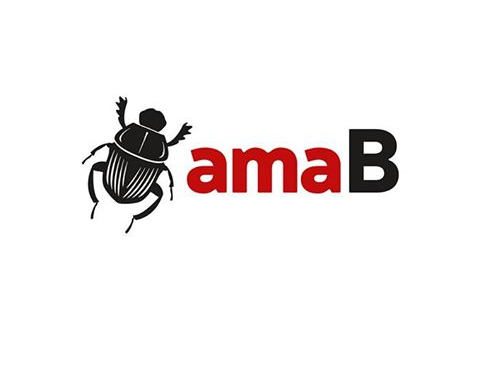
The amaBhungane Centre for Investigative Journalism, an independent non-profit, produced this story. Like it? Be an amaB supporter to help it do more.

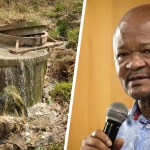




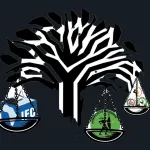









 Become an Insider
Become an Insider